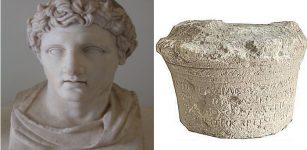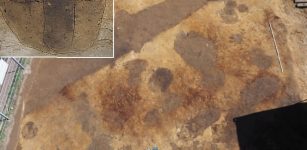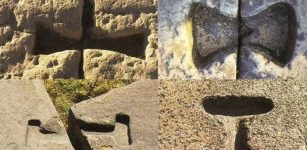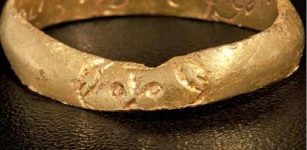Queen Dido Of Carthage: Founder Of Prosperous City On Africa’s Northern Coast
A. Sutherland - AncientPages.com - The oldest story about Dido was written by Timaeus, an ancient Greek historian who lived in the 3rd century BC. Dido’s original name ‘Elissa’ is related to El, the remote Phoenician creator god El.
From the first stories written about Dido, we learn that she was the daughter of the King of Tyre (a city in the country now known as Lebanon) and she was married to Acerbas who was a priest of Hercules.
The Death of Dido. Andrea Sacchi (1599–1661) - Public Domain
Unfortunately, her husband was killed by her own brother, Pygmalion, and Dido decided to leave her native Tyre, secretly with all her dead husband’s treasures. Elissa, best known as Dido ("the wanderer"), gathered a group of rich Phoenicians and set out on a journey. At last, after having long wandered, they went first to Cyprus, and then to the north coast of Africa in the place now known as Tunisia. They landed on the coast of the Mediterranean, in the gulf where Utica stood.
It was almost fifteen miles from Tunis, famous at this time for its corsairs. After she arrived with her people, she asked Iarbus, the Berber ruler, if she could buy some piece of land in order to settle and start a new life with her people.
Iarbus agreed but under one condition: she could buy as much land as the ox skin would cover. Dido was a very intelligent woman; she instructed her people to cut the skin of the animal into very thin strips. Then, her people covered the piece of land with the strips and thus they marked its borders.
The empty piece of land in a foreign country developed into a city and home for Dido and her people. The city was named Carthage, and Dido became the city’s first queen. Soon Carthage became a prosperous city, in which many local Berbers wanted to live.
When the power of the city grew, Iarbus demanded a marriage with Dido, threatening war if she refused.
Dido still loved her husband Acerbas. What could she do?
Dido Makes Her Decision – Wedding Is Off
Just before her wedding, she built a large fire to honor her murdered loving husband, Acerbas. Iarbus king of Getulia, would be her new husband, and he threatened with a war in case of refusal.
However, this wedding never took place because Dido had other plans. She climbed on the pyre and drawing out a dagger which she had concealed under her robe, she stabbed herself with it in front of her people’s eyes.
Dido died but among the Carthaginians, she was never forgotten. They worshiped her as a goddess and their city that Dido helped to establish was rich for 600 years until it was destroyed by Rome in 146 BC.
 Dido is buying the land for her future city of Carthage. Image credit: Mathias Merian the elder - Historische Chronica Frankfurt 1630 - Public Domain
Dido is buying the land for her future city of Carthage. Image credit: Mathias Merian the elder - Historische Chronica Frankfurt 1630 - Public Domain
A slightly different version of Dido’s story but in fact, the most popular epic, written by a Roman poet Virgil (70 BC-19 BC). According to him, while Queen Dido lived in Carthage, her city was visited by Aeneas, the ancestor of the Romans and the hero escaping from the defeated Troy.
The two fall in love and Aeneas decides to stay in Carthage as the city’s co-ruler with Dido. But the Roman gods Jupiter and Mercury remind him that he has a mission to accomplish, so unhappy Aeneas must leave Carthage and Dido and travel to Italy.
Sad and disappointed Dido commits suicide with the sword that she gave Aeneas when he first came to her city. The two former lovers meet once again when Aeneas visits the Underworld. He tries to speak to her but she turns away from him in silence. Apparently Dido never truly forgave him for his decision to leave her.
Written by – A. Sutherland - AncientPages.com Senior Staff Writer
Copyright © AncientPages.com All rights reserved. This material may not be published, broadcast, rewritten or redistributed in whole or part without the express written permission of AncientPages.com
Expand for referencesReferences:
Cotterell, A. A Dictionary of World Mythology
Rollin, Ch. A Short History of Carthage
Kulesza Ryszard, Słownik kultury antycznej
More From Ancient Pages
-
 Exceptional Precision And Technical Mastery Of Iberian Archery From 7,000 Years Ago
Archaeology | Dec 27, 2024
Exceptional Precision And Technical Mastery Of Iberian Archery From 7,000 Years Ago
Archaeology | Dec 27, 2024 -
 Remains Of 2,500-Year-Old Aphrodite Temple Unearthed In Turkey
Archaeology | Jan 7, 2021
Remains Of 2,500-Year-Old Aphrodite Temple Unearthed In Turkey
Archaeology | Jan 7, 2021 -
 Never-Before-Seen Face Of A Tattooed Tashtyk Man Hidden Behind A Gypsum Death Mask Revealed
Archaeology | Jul 17, 2020
Never-Before-Seen Face Of A Tattooed Tashtyk Man Hidden Behind A Gypsum Death Mask Revealed
Archaeology | Jul 17, 2020 -
 2,000-Year Old Engraved Kurdistan Tablet Referring To A Hellenistic Ruler Demetrius – Analyzed
Archaeology | Dec 14, 2020
2,000-Year Old Engraved Kurdistan Tablet Referring To A Hellenistic Ruler Demetrius – Analyzed
Archaeology | Dec 14, 2020 -
 On This Day In History: American General Benedict Arnold Commits Treason – On Sep 21, 1780
News | Sep 21, 2015
On This Day In History: American General Benedict Arnold Commits Treason – On Sep 21, 1780
News | Sep 21, 2015 -
 Aristotle’s Influence On Education Of Alexander The Great – Historical Encounter Of Two Famous Men
Featured Stories | Dec 24, 2018
Aristotle’s Influence On Education Of Alexander The Great – Historical Encounter Of Two Famous Men
Featured Stories | Dec 24, 2018 -
 William Marshal Earl Of Pembroke: Master Of Tournaments And Best Example Of Medieval Chivalry And Knighthood
Featured Stories | Jul 7, 2017
William Marshal Earl Of Pembroke: Master Of Tournaments And Best Example Of Medieval Chivalry And Knighthood
Featured Stories | Jul 7, 2017 -
 Ancient Skeletons Reveal Britain Suffered From Parasite Infections Since The Bronze Age
Archaeology | Apr 22, 2022
Ancient Skeletons Reveal Britain Suffered From Parasite Infections Since The Bronze Age
Archaeology | Apr 22, 2022 -
 Roman Naval Base of Haltern in Germany Was Rebuilt Four Times 2,000 Years Ago
Archaeology | May 8, 2023
Roman Naval Base of Haltern in Germany Was Rebuilt Four Times 2,000 Years Ago
Archaeology | May 8, 2023 -
 Catacombs Of Kom El Shoqafa – Largest Roman Burial Site In Egypt
Featured Stories | Feb 8, 2021
Catacombs Of Kom El Shoqafa – Largest Roman Burial Site In Egypt
Featured Stories | Feb 8, 2021 -
 Melipona Beecheii – Sacred Ancient Maya Beekeeping Site Discovered In Quintana Roo, Mexico
Archaeology | May 28, 2024
Melipona Beecheii – Sacred Ancient Maya Beekeeping Site Discovered In Quintana Roo, Mexico
Archaeology | May 28, 2024 -
 Mystery Of Ancient Metal Clamps – Advanced Lost Technology Modern Science Still Cannot Explain
Ancient Technology | Jul 31, 2020
Mystery Of Ancient Metal Clamps – Advanced Lost Technology Modern Science Still Cannot Explain
Ancient Technology | Jul 31, 2020 -
 Mysterious Unknown Strange-Looking Ancient Seafarers – Survivors Of A Now Vanished Race?
Civilizations | Oct 11, 2022
Mysterious Unknown Strange-Looking Ancient Seafarers – Survivors Of A Now Vanished Race?
Civilizations | Oct 11, 2022 -
 Did Ancient Civilizations Possess Knowledge Of Time Travel?
Ancient Technology | Sep 17, 2018
Did Ancient Civilizations Possess Knowledge Of Time Travel?
Ancient Technology | Sep 17, 2018 -
 Dargavs: Strange City Of The Dead – Mysterious Village And Ancient Cemetery Shrouded In Myths
Featured Stories | Nov 25, 2017
Dargavs: Strange City Of The Dead – Mysterious Village And Ancient Cemetery Shrouded In Myths
Featured Stories | Nov 25, 2017 -
 Controversial Hollow Earth Theory – Questions And Answers – Part 3
Featured Stories | Jun 28, 2019
Controversial Hollow Earth Theory – Questions And Answers – Part 3
Featured Stories | Jun 28, 2019 -
 Cryptic Ice Age Markings In European Caves Deciphered – Proto-Writing Discovered By Amateur Archaeologist
Archaeology | Jan 5, 2023
Cryptic Ice Age Markings In European Caves Deciphered – Proto-Writing Discovered By Amateur Archaeologist
Archaeology | Jan 5, 2023 -
 Skulls and inscriptions on three rings found by archaeologists in Wales
Artifacts | Aug 29, 2015
Skulls and inscriptions on three rings found by archaeologists in Wales
Artifacts | Aug 29, 2015 -
 Huge 2,000-Year-Old Roman Basilica Discovered In Israel May Have Been Built By Herod The Great
Archaeology | Jul 29, 2021
Huge 2,000-Year-Old Roman Basilica Discovered In Israel May Have Been Built By Herod The Great
Archaeology | Jul 29, 2021 -
 1,800-Year-Old Relief Of Mythological Satyr Figure Under Restoration
Artifacts | Sep 5, 2020
1,800-Year-Old Relief Of Mythological Satyr Figure Under Restoration
Artifacts | Sep 5, 2020

